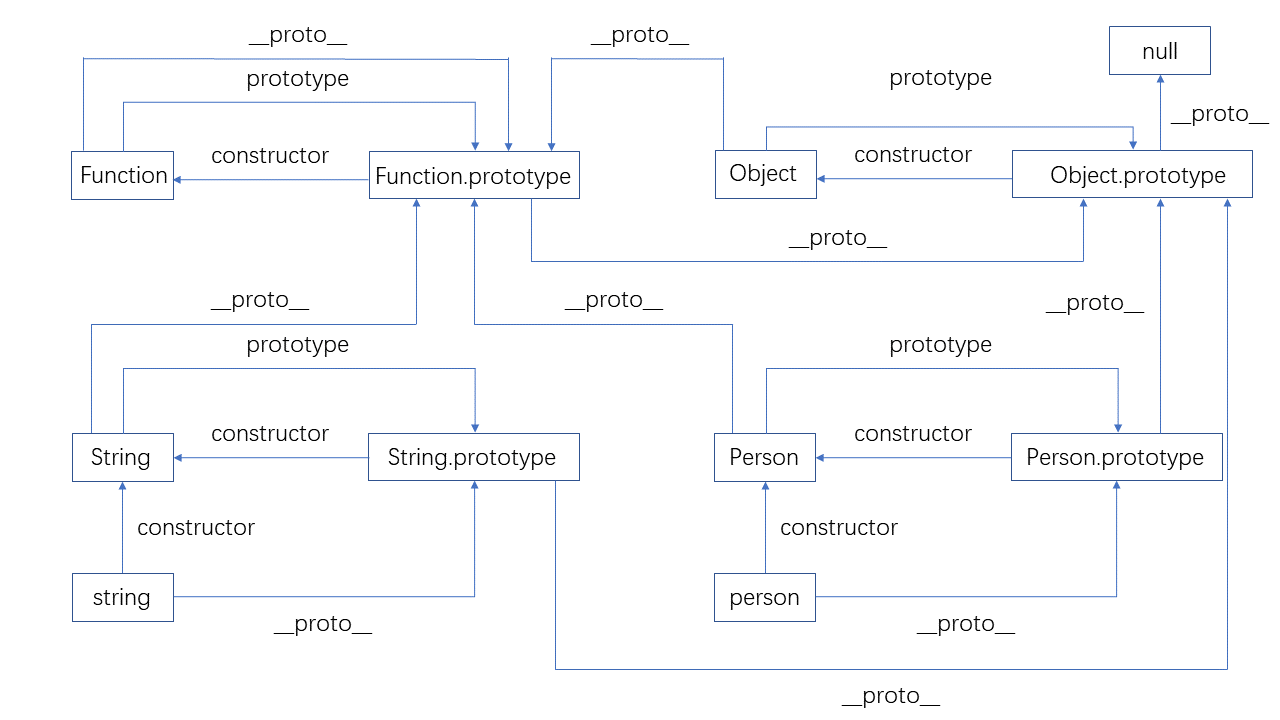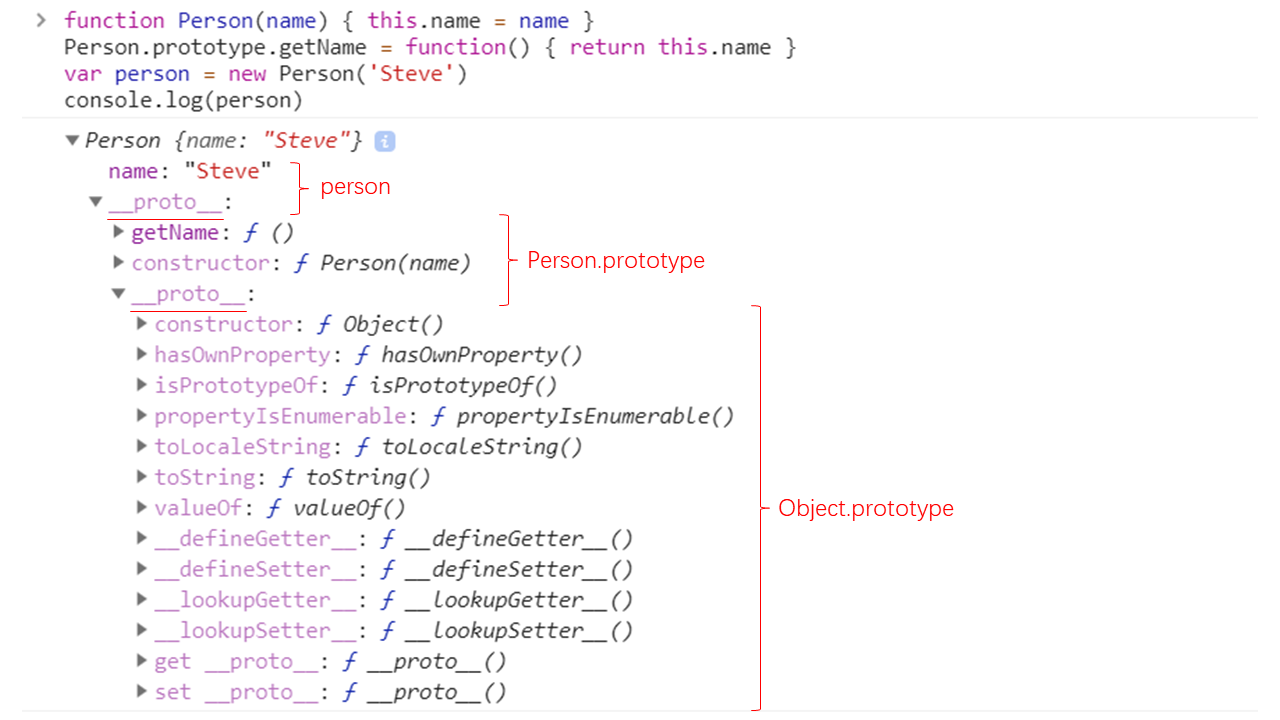之前看原型和原型链的时候,总是看得迷迷糊糊的,最近就趁着有空重新整理了一下,其实发现并不难
下面我们一步一步跟着,彻底弄清楚原型和原型链吧
1、原型
- 每个 实例对象 都有一个
constructor属性,指向它的构造函数
function Person(name) {
this.name = name
}
var person = new Person('Steve') // 自定义构造函数
var string = new String('Hello') // 原生的构造函数
console.log(person.constructor === Person)
console.log(string.constructor === String)
/*
* 执行结果:
* true
* true
**/每个 函数对象(包括构造函数) 都有一个
prototype属性,指向函数的原型对象这个 原型对象 的
constructor属性,指向函数本身
function Person(name) {
this.name = name
}
var person = new Person('Steve') // 自定义构造函数
var string = new String('Hello') // 原生的构造函数
console.log(Person.prototype.constructor === Person)
console.log(String.prototype.constructor === String)
/*
* 执行结果:
* true
* true
**/每个 对象 都有一个
[[prototype]]私有属性,指向它的构造函数的原型对象,但这个属性是不允许访问的某些浏览器(例如 Chrome)提供
__proto__属性用于访问[[prototype]]私有属性
function Person(name) {
this.name = name
}
var person = new Person('Steve') // 自定义构造函数
var string = new String('Hello') // 原生的构造函数
console.log(person.__proto__ === Person.prototype)
console.log(string.__proto__ === String.prototype)
console.log(Person.__proto__ === Function.prototype)
console.log(String.__proto__ === Function.prototype)
/*
* 执行结果:
* true
* true
* true
* true
**/构造函数的
constructor属性都是指向Function,__proto__属性都是指向Function.prototype因为构造函数都是通过
new Function来创建的,它们都是 Function 的实例对象,包括 Function 和 Object
function Person(name) {
this.name = name
}
console.log(Person.constructor === Function)
console.log(Person.__proto__ === Function.prototype)
console.log(String.constructor === Function)
console.log(String.__proto__ === Function.prototype)
console.log(Function.constructor === Function)
console.log(Function.__proto__ === Function.prototype)
console.log(Object.constructor === Function)
console.log(Object.__proto__ === Function.prototype)
/*
* 执行结果:
* true
* true
* true
* true
* true
* true
* true
* true
**/除
Object外,其它构造函数的prototype属性的__proto__属性都是指向Object.prototype而
Object的prototype属性的__proto__属性指向null
function Person(name) {
this.name = name
}
console.log(Person.prototype.__proto__ === Object.prototype)
console.log(String.prototype.__proto__ === Object.prototype)
console.log(Function.prototype.__proto__ === Object.prototype)
console.log(Object.prototype.__proto__ === null)
/*
* 执行结果:
* true
* true
* true
* true
**/最后来一张图片总结一下,虽然看起来有点复杂,但是只要大家找到规律,就会很简单了
建议大家分类来看,注意哪里出现 constructor 属性,哪里出现 prototype 属性,哪里出现 __proto__ 属性

2、原型链
(1)原型链
上面我们说过,所有对象都有 __proto__ 属性,并且这个 __proto__ 属性指向一个原型对象
因为原型对象也是对象,这个原型对象也有 __proto__ 属性,我们把这种关系称为原型链

(2)属性访问
当需要访问一个对象的属性时,首先从该对象开始查找,如果能够找到,那么到此返回
如果没有找到,就在该对象的 __proto__ 属性指向的原型对象中继续查找,如果能够找到,那么到此返回
如果没有找到,那么一直往上查找原型对象,直至 __proto__ 属性指向 null,也就是原型链的顶端
若原型链上的所有原型对象都没有该属性,则返回 undefined
function Person(name) { this.name = name }
Person.prototype.getName = function() { return this.name }
var person = new Person('Steve')
var name = person.getName() // 在 Person.prototype 中找到
var description = person.toString() // 在 Object.prototype 中找到
var age = person.age // 在原型链中无法找到
console.log(name)
console.log(description)
console.log(age)
/*
* 执行结果:
* Steven
* [object Object]
* undefined
**/(3)属性检测
in操作符:检测属性是否在对象的原型链上hasOwnProperty方法:检测属性是否来自对象本身
function Person(name) { this.name = name }
Person.prototype.getName = function() { return this.name }
var person = new Person('Steve')
console.log('age' in person)
console.log('name' in person)
console.log('getName' in person)
console.log('toString' in person)
console.log(person.hasOwnProperty('age'))
console.log(person.hasOwnProperty('name'))
console.log(person.hasOwnProperty('getName'))
console.log(person.hasOwnProperty('toString'))
/*
* 执行结果:
* false
* true
* true
* true
* false
* true
* false
* false
**/3、为什么要使用原型
JavaScript 中的继承是基于原型的,原型的作用在于不同实例对象之间可以共享数据,节省内存
function Person(name) { this.name = name }
Person.prototype.getName = function() { return this.name }
var person1 = new Person('Steve')
var person2 = new Person('Steven')
// 不同实例对象 person1 和 person2 都可以使用在 Person.prototype 上定义的 getName(共享数据)
// 从而避免在每个实例对象上都要重复定义 getName(节约内存)
var name1 = person1.getName()
var name2 = person2.getName()
console.log(name1)
console.log(name2)
/*
* 执行结果:
* Steve
* Steven
**/4、要怎么样使用原型
为一个对象添加原型有三种方式,分别是 new 关键字、class 关键字和 Object.create 方法
其中,class 关键字其实是 new 关键字的语法糖
new关键字
function Person(name) {
this.name = name
}
Person.prototype.getName = function() {
return this.name
}
var person = new Person('Steve')
var prototype = Object.getPrototypeOf(person)
console.log(prototype)class关键字
class Person {
constructor(name) {
this.name = name
}
getName() {
return this.name
}
}
var person = new Person('Steve')
var prototype = Object.getPrototypeOf(person)
console.log(prototype)Object.create方法
var object = {
name: 'Steve',
getName: function() {
return this.name
}
}
var person = Object.create(object)
var prototype = Object.getPrototypeOf(person)
console.log(prototype)【 阅读更多 JavaScript 系列文章,请看 JavaScript学习笔记 】